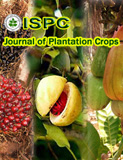Export competitiveness of Indian plantation crops in EU and NAFTA
Abstract
The proliferation of multilateral trade agreements has opened plethora of trade opportunities and increased market access for Indian plantation crops. At the same time, the emergence of low-cost producers in Latin America, Asia and Africa as well as the Non-Tariff Barriers poses as a threat for the competitiveness of India’s plantation exports. In the given context, this study attempts to assess the export potentials of the selected plantation crops to two major trade blocs i.e., European Union (EU) and NAFTA (North American Free Trade Area). The three crops analyzed in the study are tea, coffee and pepper. The export competitiveness is analysed using the Revealed Comparative Advantage Index and Trade Complementary Index, each of which reveals the competitiveness and export potentials respectively. The study reveals a strong complementary trading structure for all the three selected crops, indicating high trading potentials and gains from trade with NAFTA. Moderate competitiveness along with a high degree of complementary trading structures is observed in the case of tea exports to NAFTA and pepper exports to the European Union. The coffee exports exhibit low to nil competitive strength in both trading blocs; however, the degree of trading complementarities range from medium to high with respect to coffee trade between EU and NAFTA respectively. The study reveals that the EU is the major export destination for Indian Tea and NAFTA for Pepper and India is losing competitiveness in Coffee exports globally as well as in the concerned destinations and EU.
Downloads
References
Bastine, C.L., Thomas, J., Narayanan, S. and Aswathy, N., 2004. Cost of production and capital productivity of coconut in Kerala, India. Journal of Plantation Crops, 32(1), pp.51-54.
Chand, R., Saxena, R. and Rana, S., 2015. Estimates and analysis of farm income in India, 1983–84 to 2011–12. Economic and Political Weekly, pp.139-145.
Deepika, M.G., 2017. Export performance and factors affecting competitiveness of plantation commodities in India. Indian Journal of Agricultural Economics, 72(4), pp.555-575.
Ghose, A.K., 2019. Employment in India. Oxford University Press.
Gulati, A. and Narayanan, S., 2003. The subsidy syndrome in Indian agriculture. OUP Catalogue.
ITC Trade Map, statistics on exports and imports of commodities available online at http://www.trademap.org/Country_SelProductCountry_TS.aspx.
Joseph, K.J., 2009. ASEAN-India Pact and Plantations: Realities of the Myths, Economic and Political Weekly, Vol.44, No.44, 31 October, pp.14-16.
Joseph, K.J., 2010. Towards a New Paradigm for Plantation Development in India: An Analysis of the System of Production and Innovation from an Inclusive Growth Perspective., NRPPD Discussion Paper 1, CDS Trivandrum.
Kumareswaran, T., Kamalvanshi, V., and Badal, P. S., 2022. Trade competitiveness and trend pattern of plantation crop exports in India.
Mukherjee, A., and Ghose, A., 2016. Impact of ASEAN-India FTA on Plantation Sector. Journal of International Trade and Development.
Nagoor, B.H., 2010. Trade aspect of plantation sector of India. National Research Programme on Plantation Development Discussion Paper, 8.
Nagoor, B.H. and Kumar, C.N., 2010. Assessing the Impact of the ASEAN-India FTA on the Tea Industry. Economic and Political Weekly, pp.112-116.
Sarkar, S., 2019. Labour migration in the tea plantations: colonial and neo-liberal trajectories of plantation labour in the dooars tea belt of West Bengal. Journal of Migration Affairs, 2(1), pp.25-43.
Veeramani, C. and Saini, G.K., 2012. Impact of ASEAN-India FTA on India's plantation commodities: A Simulation analysis.
Yeats Alexander. 1992. “What do alternative measures of comparative advantage reveal about the composition of developing countries' exports?” Indian Economic Review: 139- 154.
Published
How to Cite
Issue
Section
Copyright (c) 2025 Journal of Plantation Crops

This work is licensed under a Creative Commons Attribution 4.0 International License.







 .
.